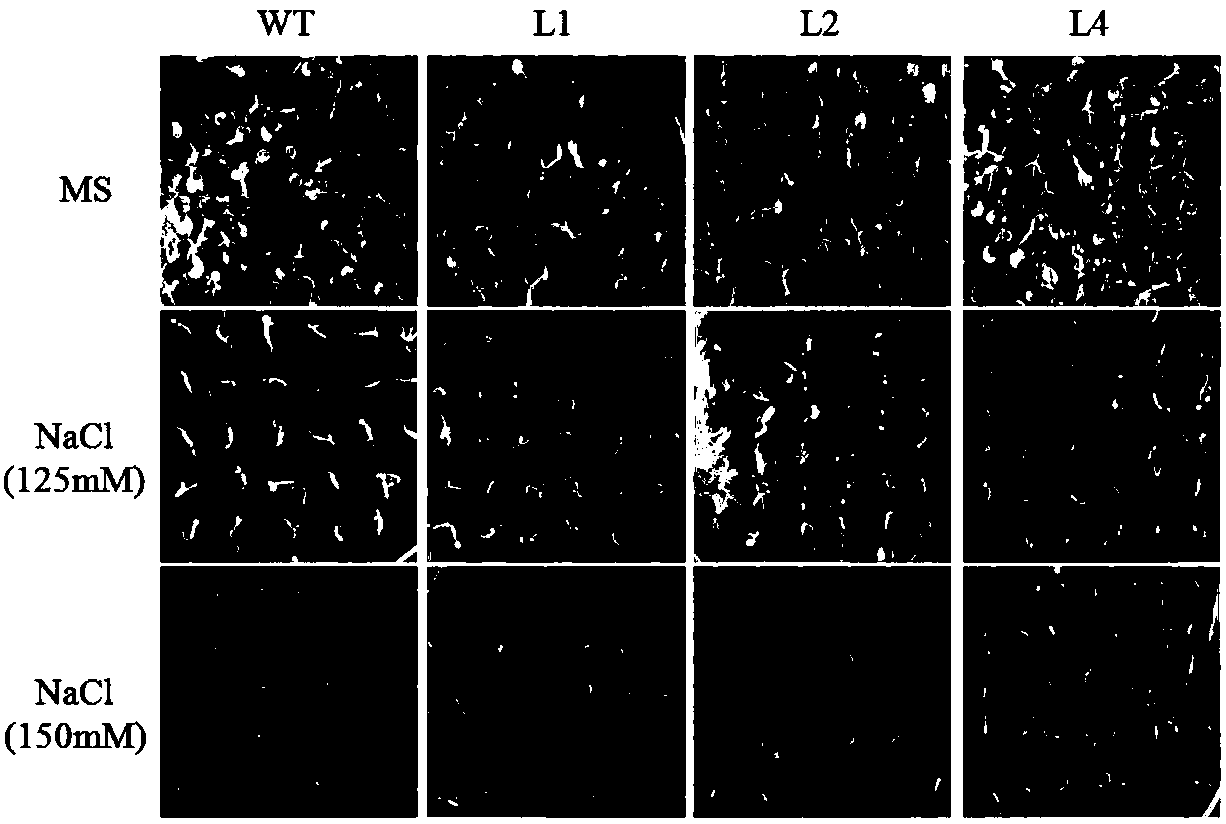Maize calcineurin B albuminoid ZmCBL10 gene and applications thereof
A technology of calcineurin and gene, which is applied in the field of corn calcineurin B similar protein ZmCBL10 gene, can solve the problems that the research on the function of corn CBL gene has not yet been applied.
- Summary
- Abstract
- Description
- Claims
- Application Information
AI Technical Summary
Problems solved by technology
Method used
Image
Examples
Embodiment 1
[0033] Embodiment 1 Containing the construction of the expression vector of ZmCBL10 gene
[0034] 1. According to the sequence of the known target gene (as shown in SEQ ID No.2), design primers with HA tag tails, amplify the ZmCBL10 gene sequence from maize cDNA, and recover the target fragment with an agarose gel kit.
[0035] 2. Ligate the recovered fragments with the pGWC-T vector, then transform DH5α competent cells, obtain positive monoclonals, send them for sequencing, and obtain monoclonals consistent with the original sequence after sequence comparison, shake the bacteria and extract the monoclonal plasmid , and named it pGWC-ZmCBL10-HA.
[0036] 3. Mix pGWC-ZmCBL10-HA and pEarleyGate100 plasmids, add LR enzyme, and obtain recombinant vector pEarleyGate100-ZmCBL10-HA after LR reaction (such as figure 1shown). Afterwards, DH5α competent cells were transformed, and the obtained positive monoclonals were sent for sequencing, which were confirmed by sequence comparison. ...
Embodiment 2
[0037] Example 2 Transformation and Screening Containing CBL10 Gene
[0038] 1. The constructed ZmCBL10 overexpression vector was transformed into Agrobacterium GV3101.
[0039] 2. Transformation of wild type Arabidopsis thaliana by floral dipping method.
[0040] 3. The T1 generation seeds obtained after the transformation were vernalized for 3 days, and then directly sowed in nutrient soil for growth. After about two weeks of normal growth, the T1 generation Arabidopsis thaliana was sprayed with 0.5‰ of PPT (phosphinothricin) to screen the transformed plants.
[0041] 4. Since the plant overexpression vector used has the Basta gene of resistance to PPT (phosphinothricin), it can be transferred to the plant body with the gene of interest when transformed, so most of the untransformed plants die after spraying PPT (phosphinothricin). The transformed plants can still grow normally. Transformed plants were harvested from T2 generation seeds according to different lines.
[00...
Embodiment 3
[0044] Example 3 Nucleic acid PCR analysis of transgenic plants containing maize CBL10 gene
[0045] 1. Using the total DNA of the extracted positive plants as a template, use ZmCBL10 gene primers to perform PCR amplification. The positive plants can amplify the 642bp band, while the wild-type plants cannot amplify the target band, such as figure 2 As shown in A. The results of Westernblot detection are as follows: figure 2 Shown in B.
[0046] 2. After harvesting the T2 generation seeds of each transgenic line, the seeds were disinfected with 0.5% NaClO. Then spot-planted in MS medium plates containing 0.5‰ of PPT (phosphinothricin) (about 50 seeds were needed for each transgenic line), and the wild type was used as a negative control.
[0047] 3. Three days after vernalization, place them in a light incubator at 22°C for growth, and observe the growth of the seedlings one week later. The wild type cannot survive in MS medium containing 0.5‰ PPT (phosphinothricin).
[...
PUM
 Login to View More
Login to View More Abstract
Description
Claims
Application Information
 Login to View More
Login to View More - R&D
- Intellectual Property
- Life Sciences
- Materials
- Tech Scout
- Unparalleled Data Quality
- Higher Quality Content
- 60% Fewer Hallucinations
Browse by: Latest US Patents, China's latest patents, Technical Efficacy Thesaurus, Application Domain, Technology Topic, Popular Technical Reports.
© 2025 PatSnap. All rights reserved.Legal|Privacy policy|Modern Slavery Act Transparency Statement|Sitemap|About US| Contact US: help@patsnap.com



